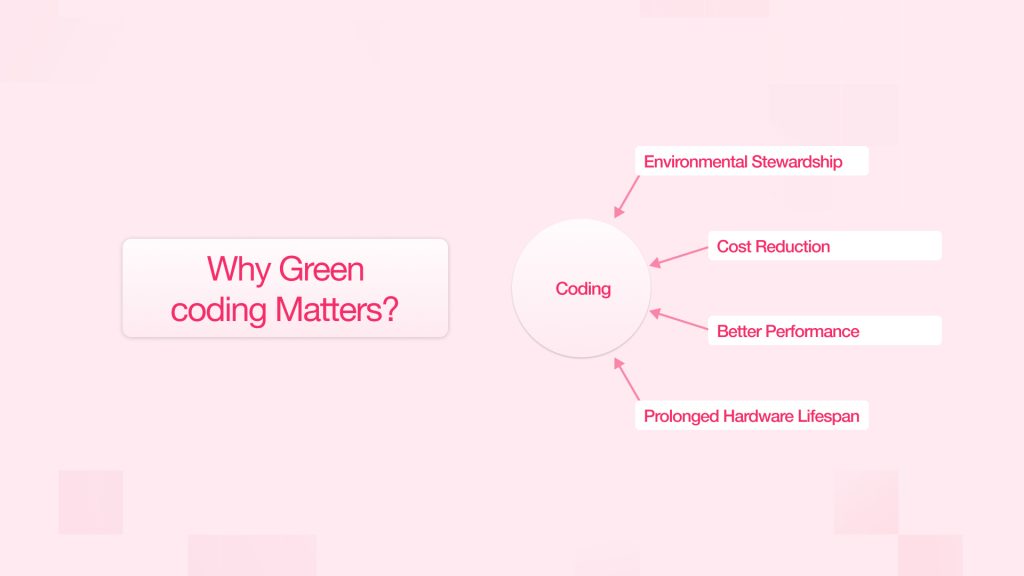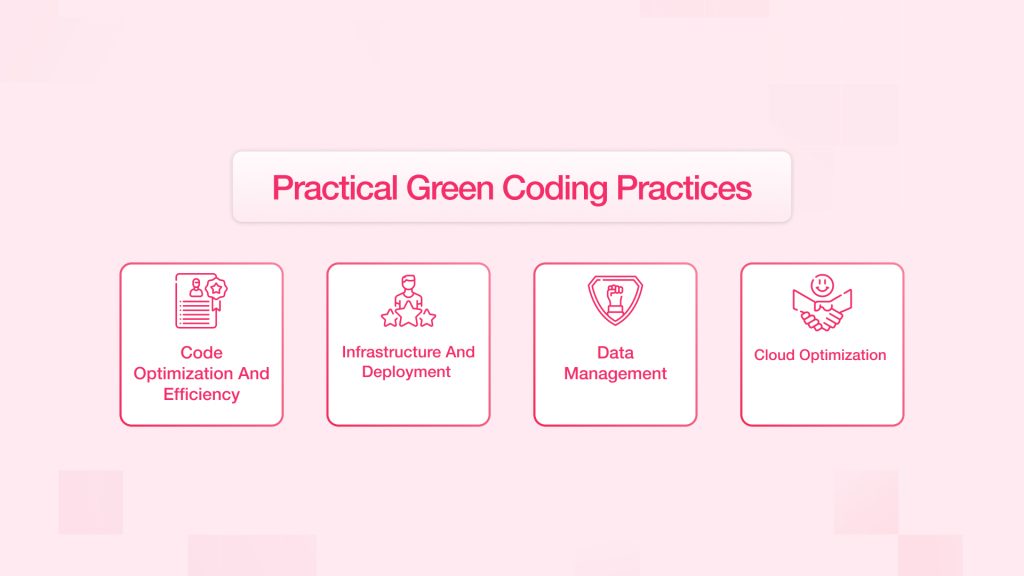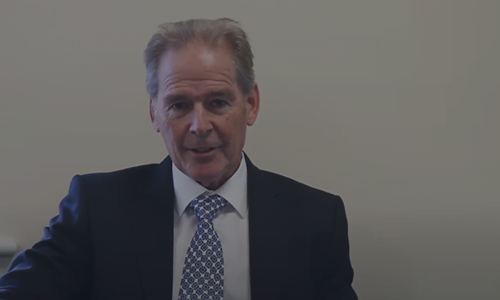Green Coding: Responsible Programming for a Sustainable Future

In a world where we use more and more digital tools, people are starting to worry about what modern tools do to the environment. Our online lives need a lot of power. This is true for big data centers and for all the devices we use to connect. One big step to help with this is green coding. Green coding is a way people write software to keep our world safe. This way of working tries to make programs that use less energy and need fewer things to run.
This blog will go over the basics of green coding. It will also talk about why green coding is so important. You will get to see some simple ways to use green coding right now. We will talk about how it can help us work toward a better and greener world for all of us.
Understanding Green Coding
Green coding, also called sustainable software engineering, is all about writing code and using hardware in a way that uses less energy and fewer materials. The main goal is to make software work better to lower the harmful effects of tech on the environment. This means making apps that do not need a lot of hardware. By doing this, there will be less use of electricity and not as much carbon is sent out when you run computers and other tools. It is a big move toward making better and more caring IT ideas for our world.
The need for green coding comes from the high use of energy in the information and communications field. Over the past ten years, data centers have used more and more energy. Computers and IT work are now a big part of the world’s greenhouse gas problem. Green coding tries to solve this by cutting down on the use of energy at every step. This includes the buildings, the way things are processed, and in how people make and run software (DevOps).
Why Green Coding Matters
The benefits of using green coding go further than helping the environment. It also gives real advantages to groups and to the tech world as a whole.

- Environmental Stewardship: The most clear good thing here is that it helps lower harm to the environment. Green coding helps us use less energy when making software. It can bring down the amount of greenhouse gases we send into the air. This way of coding also reduces how much hardware tools we need, and it helps us use what we have in a better way. All of this helps us in the big job of fighting climate change and lets us move toward a world with less carbon in it.
- Cost Reduction: The way your company uses energy is tied to how much it spends to run things each day. When you build software that uses less power, you can save a lot of money on electric bills and keeping things cool. The chance to save this money makes green coding a good choice for any business that wants to work better.
- Better Performance and Energy Use: Making code better for energy use often helps the whole software work well. Good algorithms, moving less data, and using memory in a smart way all help apps run faster and respond better. This can make the user experience and how well things work better, too.
- Prolonged Hardware Lifespan: Using software that needs less computer power and memory is good for your hardware. It helps the servers, computers, and other devices last longer. This means you do not have to change your hardware as often. It helps cut down on electronic waste.
Practical Green Coding Practices
Implementing green coding needs some changes in the way things are done and how people work together in an organization. Developers, architects, and product managers each have a part to play in this work. Everyone has to help to make it happen.

Code Optimization and Efficiency
Efficient Algorithms and Data Structures: Choosing the best algorithms for a task helps to cut down on the computer power and time it takes to finish the job. In the same way, having the right data structures can also help to use less memory and make things run faster.
Minimizing Data Sending: Every byte that goes through networks uses energy. Developers should try to lower the amount and how often they send data by:
- Compressing data before transmission.
- Set up good caching methods to stop getting the same data over and over again.
- Designing APIs that get only the most important information.
Optimizing Database Queries: When you have database queries that are not set up well, they can use a lot of extra power. If you set up your queries in a better way, use the right indexing, and do not pull more data than you need, it can help speed things up. This will use less power and make the system work better.
Resource Management: Make sure to use your system power, memory, and CPU in a careful way. When you no longer need something, let it go. This helps stop your device from using too much power.
Refactoring and Removing Unused Features: As time goes on, software picks up features that people may not use anymore. It is good to go back and clean up the code often. When you take out things that are not needed, there will be less code to work with. This makes software development smaller and faster. It is a good way to make sure this works better for people who use it.
Addressing Intensive Loops: Finding and fixing heavy loops in the code can help save a lot of energy. These parts usually use up a lot of processing power.
Need a Reliable Software Development partner to help grow your Business?
Our Experts Can Help!
Infrastructure and Deployment
Sustainable Cloud Solutions: When you choose cloud computing providers that use renewable energy for their data centers, you take an important step. Many cloud providers now give clear reports about their work to help the environment.
Virtualization and Containers: Using virtual machines and containers lets you get the most out of your hardware. You can run more than one separate app on just one server. This means you do not need as many servers.
Microservices Architecture: When you break big apps into smaller parts called microservices, it makes better use of what you have. You only need to run the services you need, so this way, you use less energy. In big, all-in-one apps, the whole thing has to be working at once. This uses more power.
Serverless Computing: Serverless functions use the computer power and storage only when they are doing something, like handling a request. This means they use what is needed at the time, which is a good way of saving energy. They do not run all the time like always-on servers, so they need less energy and work better.
Data Management
Good ways to store and get data are very important. You need to make sure that database searches work well. Use the right indexes. Try to only get the data that you need. Put in place good ways to store data for quick use, like caching. When you cut down on how much data you move and work with, you use less energy.
Cloud Optimization
For applications that are on the cloud, pick cloud providers who care about being better for the environment. Use services made for the cloud, like serverless functions, to help lower the negative impact on the earth. Cloud optimization means setting things up so they work as well as they can and watching how much you use, so nothing goes to waste.
Looking for a Partner in Your Digital Transformation Journey?
We Can Help!
Conclusion
It’s clear that in our world today, the way we use new gadgets and machines has a real effect on our planet. This is about everything— from the big data centers full of servers to the small devices that you and I hold every day. But there is good news. Green coding gives us a smart way to be better programmers. It helps us make the environment better. This is not just a popular idea. It is a big change in how we see building computer programs.
By using smart code and choosing carefully how we set up things and handle data, we can really help cut our shared carbon footprint. Think about this: when we make algorithms better, move less data, or pick cloud companies that use green energy, we do more than just change the tech. We are taking real steps that lead to saving energy and making less waste. On top of that, these earth-friendly choices can help us save money too, like by lowering power bills and letting our hardware last longer. Plus, things will usually run better. If your code is good for the planet, it also works better for the people using it.
Choosing green coding is not just about doing the right thing. It is a good move for anyone in tech who wants to do well today. This also helps us stand out as leaders who care about caring for the earth and making things better. Let’s try to bring these habits into our work every day. Together, we can help make the world better, step by step, as we write each line of code. What will you do to help your code use less energy and be more green?
 Shopify
Shopify










